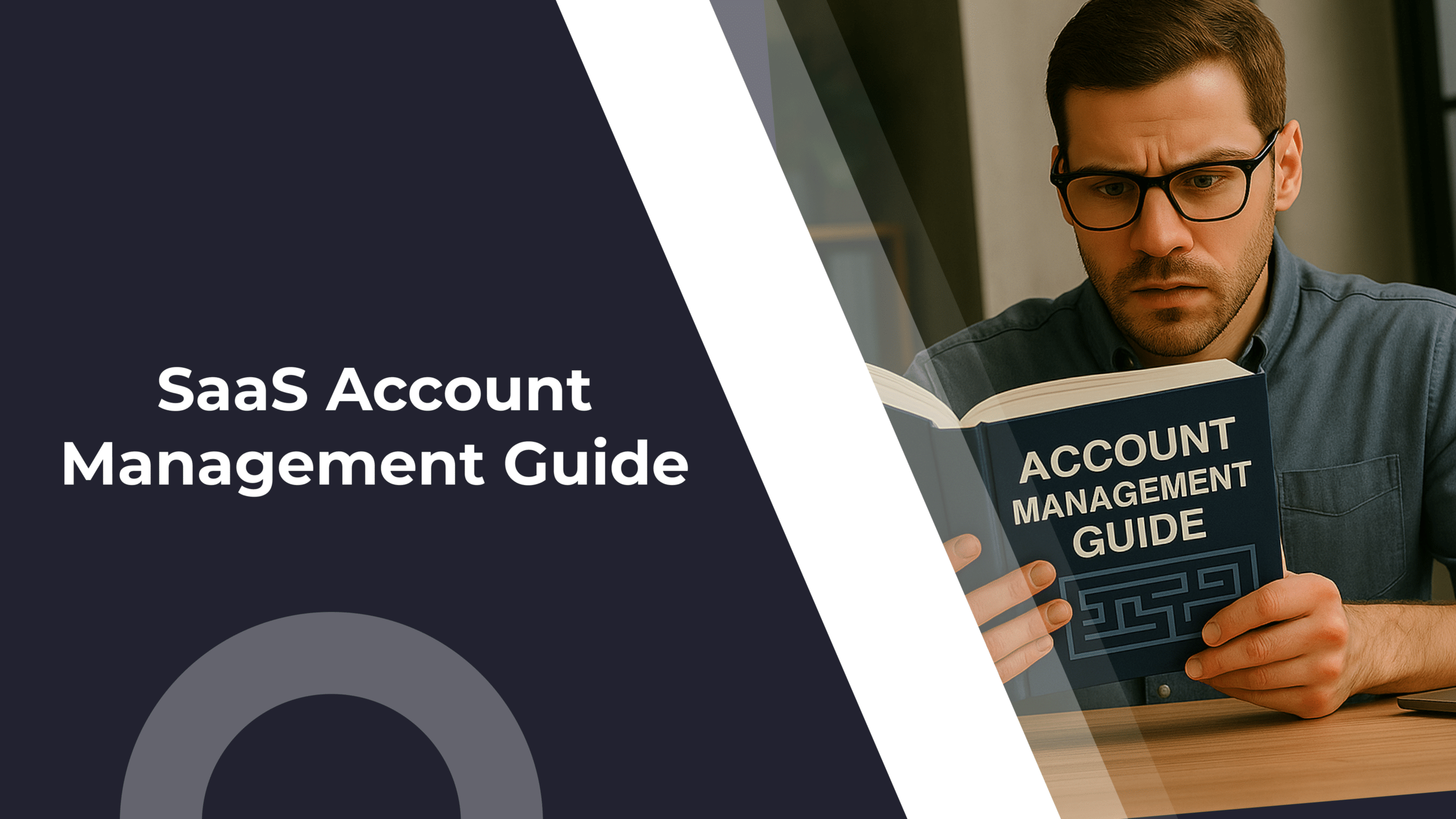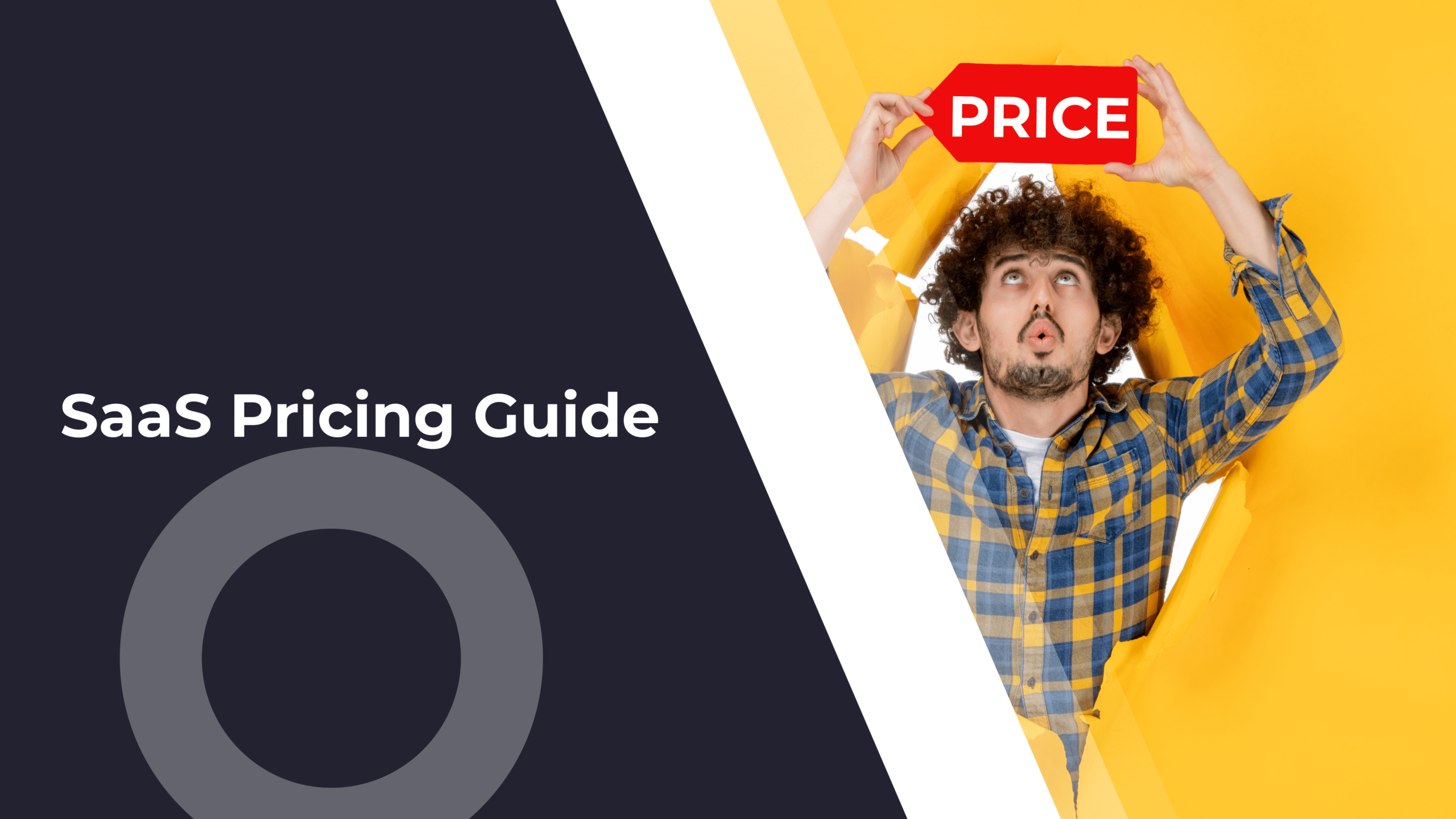When it comes to growing any business’ revenue, everybody’s got an opinion. Search online, and you’ll get a myriad of tips, strategies, and “proven” ways of doing it. Not that there’s anything particularly wrong with any of them. No. However, before trying hacks and gimmicks I’d recommend understanding the basics of boosting a business’ revenue. Because, at the end of the day, there are only 3 ways to achieve this:
- Sell to more customers.
- Sell more products to the same customers
- Sell the same products to the same customers repeatedly
Simple is better.
‘Alright, alright, but what’s this gotta do with upselling and cross-selling?’ -you reluctantly ask. Well, it’s quite simple. Both upselling and cross-selling are methods that will help you sell more products to your customers. This increases your Average Order Value (AOV) which in turn helps boost your revenue.
What is upselling and cross-selling?
First things first – let’s define the two techniques.
People use the word upsell around pretty much everything that drives AOV growth. However, upselling happens when you give your customer the option to upgrade his initial purchase to a product with a higher value.

Take Spotify, for example. For $3 more, they allow users to opt for a Duo account. See what we mean?
Now, what about cross-selling? Well, perhaps the best-known example of cross-selling is ‘Would you like fries with that?’. This means that cross-selling is the technique of offering products that complement and expand the initial purchase.

Take Norton’s example who also encourages their antivirus users to add a VPN and/or a computer tune-up software.
Catch the difference between upselling and cross-selling? Good. Onwards, then.
The importance of upselling and cross-selling for SaaS companies
It doesn’t matter what industry, market, or niche your SaaS company is operating in – if you’re not upselling and cross-selling, you’re leaving money on the table. That much is obvious.
However, the benefits of these techniques go beyond generating additional revenue for your business. Think about it: by offering your customers upgraded versions of a product or service and other complementary services to it, you’re helping them enjoy a better experience.
A better experience means happier customers. Happier customers mean loyal customers. Loyal customers mean good reviews, potential free referrals, increased visibility and credibility for your business, and an overall solid foundation for a healthy business. Oh, and let’s not forget that all this could potentially decrease your marketing and acquisition costs too. Not too bad, eh?
And there’s more. By offering your customers the chance to personalize their experience, you’re positioning yourself as a one-stop-shop solution. Compared to decentralized and fragmented one-and-done types of products or services, yours will be much, much more difficult to replace.
That’s the power upselling and cross-selling holds.

So, don’t consider these expansion techniques as ways to squeeze more money from your customer. Instead, imagine them as problem-solving and experience-enhancing tools for your customer’s initial purchase.
With this thought in mind, you’re ready to start.
How to create a killer upselling and cross-selling strategy
This is where things start to get interesting. Putting together your upselling and cross-selling strategy starts with doing your homework. After all, you’re not in the business of throwing spaghetti at the wall and seeing what sticks. Not at all.
You make informed decisions based on research, data, and user behavior. Allow yourself the time to study all these. Not only will this save you the frustration of coming up with something that doesn’t resonate with your customers, but you’ll find it waaay easier to differentiate yourself from 99% of other SaaS companies.
It goes without saying that having a potent and reliable Customer Success Software by your side – such as Custify – virtually means that more than 50% of your strategy is already done for you. You’ll understand why in the following sections.
1. Know your customers and their needs
First and foremost, it starts off with knowing your customers and understanding their needs. We’re sorry, but there’s no way around this. As such, you’ll have to take the time to do some customer research, get customer feedback, run a few interviews, and analyze user behavior – all for the purpose of identifying gaps that you can fill with additional products or upgraded plans.
This customer research phase is not your run-of-the-mill superficial browsing. You need to dig deep and get to know your audience on a soul-to-soul level.
Start with collecting feedback like a pro. Set up surveys, craft irresistible email campaigns, and encourage your customer support team to pull those golden nuggets out of every interaction. That feedback will be the beacon that guides you straight to the cross-selling and upselling promise land.

User interviews are next on your list. One-on-one interactions are your secret weapon to unlock the mysteries of your customers’ experiences, challenges, and deepest desires. Slice and dice the insights you get until you’re ready to serve them a perfectly tailored cross-selling and upselling menu.
And let’s not forget about the power of data analytics. Dive into the nitty-gritty of user behavior within your SaaS platform. Track those clicks, analyze the heck out of those engagement metrics, and spot product adoption patterns. This data is your secret decoder ring, revealing usage gaps, areas of high interest, and untapped potential for cross-selling and upselling. It’s like having X-ray vision for your customers’ desires—pure marketing superpower.
Moreover, monitoring your user’s research patterns is one of the best ways to identify those who stand to benefit the most from your upsells and cross-sells.
If your SaaS offers multiple pricing tiers, a CSP with advanced growth & upsell capabilities can automatically send you notifications that alert you when a customer is about to hit their quota or usage limits in their current tier. What better time to reach out to these customers with a concise and impactful message such as the one below:
‘Looks like someone’s been a busy bee. You’ve just hit your allocated quota of XXX today. We’re guessing you’re not even close to being done, so let’s see how we can serve your growing business needs.’
Remember when we mentioned that having a CS platform such as Custify means your job is half done? Well, that’s because Custify gathers and centralizes customer data from various sources, such as product usage, customer interactions, and user feedback. Thanks to this comprehensive view, you’ll find it a lot easier to identify your cross-selling and upselling opportunities.

2. Create different customer segments and buyer personas
Once you know your customer’s needs, you’ll probably discover various demographics, behaviors, and preferences. This is where segmentation kicks in. Grouping your customers by their preferences or usage gives you the possibility to tailor your upselling and cross-selling strategies to each segment’s needs and desires.
To do this well, you can use a complex CRM or a dedicated CS software. Segmenting can be easy if you have the right data. The trick is having an easy way to leverage these segments, such as automated outreach.
You can go above and beyond this and create buyer personas based on these segments. A buyer persona is an in-depth profile of your ideal customer. This buyer persona must include the background of your ideal customer, her goals and motivations, the challenges she faces in her pursuit of them, how a day in her life usually looks like, where she gets her information from, how she likes spending her free time – basically every aspect of her life.
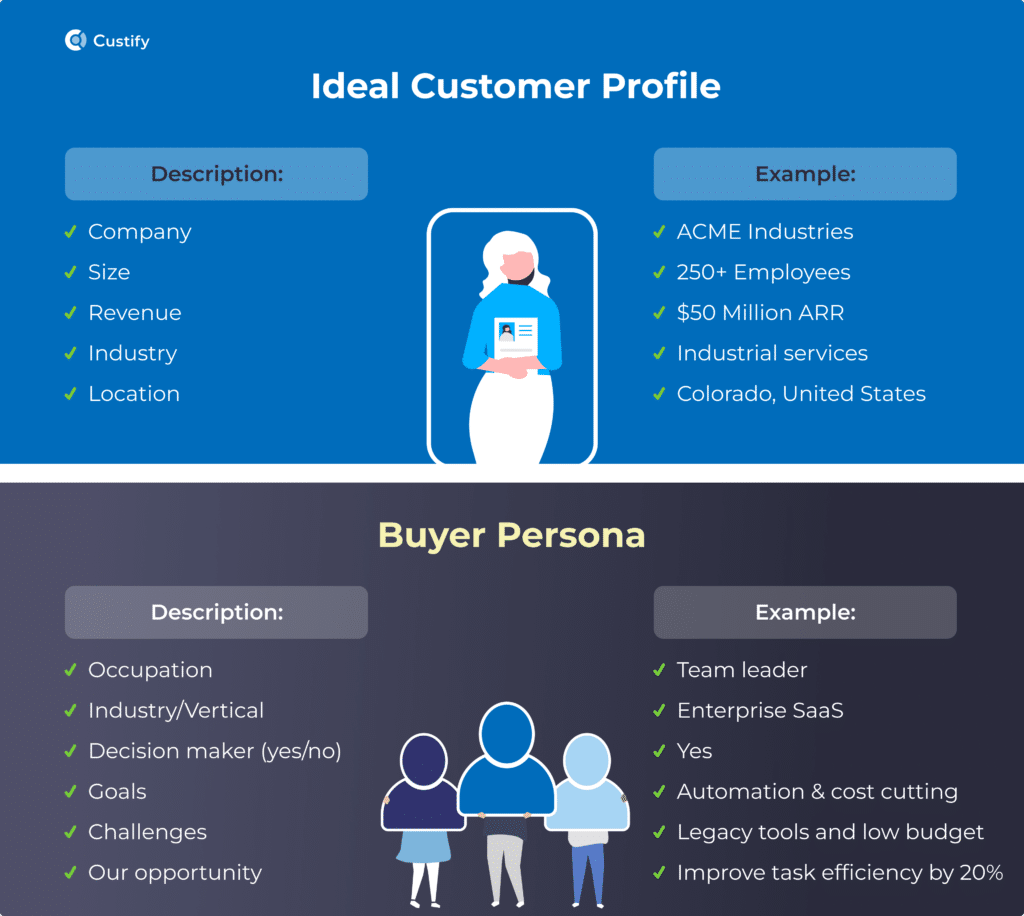
Yes, it’s not easy. And it’s certainly not fast. But it pays off in the long run when your upsells and cross-sells start cashing in.
3. Use health and customer feedback scores to identify upsell opportunities
Did you know that there are specific indicators that signal when your customers are prepared to take your relationship to the next level? It’s true.
Take, for instance, your NPS (Net Promoter Score). This is a widely used metric that gives valuable insights into customer satisfaction, loyalty, and the likelihood of your users recommending your SaaS to others. When leveraged properly, you can use this indicator to boost customer satisfaction, drive customer success initiatives, and ultimately achieve long-term business success.
Your support tickets are another great source of customer insights you mustn’t miss out on. Keep an eye out for those customers who ask questions about your product or service. Sometimes, you can find some incredible golden nuggets of information there. Imagine a scenario where one of your users asks your customer support team if your product offers a certain type of report. Unfortunately, it doesn’t – and that’s great news for you because you’ve just been handed rich insights into what to add as part of an add-on service.
Quarterly and Annual Business Reviews (QBRs & ABRs) are critical checkpoints in the marathon to customer satisfaction. During these discussions, align your rhythm with your client’s goals and necessities. These conversations are not about donning a sales hat, but about stepping into the shoes of a customer success advocate. The objective? To ensure your clients thrive, by enabling them with the tools and services they need to scale efficiently. Foster genuine dialogue, understand their pain points, and nimbly navigate to solutions. This authentic partnership sets the stage for natural upsell conversations without the hard sell, as you collaboratively celebrate milestones and plan for future victories.
4. Always check for new users and stakeholders
As a Customer Success Manager, imagine yourself as the captain of a ship on an ever-evolving sea of stakeholders. From the maiden voyage of onboarding to the seasoned waves of renewals, there are passengers who might sail smoothly without a peep. Your keen gaze needs to be on the lookout for fresh faces boarding your customer’s vessel.
Users from another department – Time for Expansion: Ding Ding! Spot a voyager from uncharted department waters tinkering with your product? Seize the moment! Extend a friendly hello, and like an excited tour guide, ask if they’re up for a virtual coffee. They might be oblivious to the fact that they have a dedicated Customer Success compass (you!) to guide them. Understand their treasure map – what are they seeking with your product?
New users from an existing department – Upsell Ahoy: Sometimes, a new sailor is ushered aboard by their manager but misses the introduction to the ship’s Customer Success Captain – that’s you! Don’t wait for a formal invite; take the initiative to send a message in a bottle (or an email) to get to know their role and future engagements with your product.
Is the new stakeholder charting new courses? Might they need extra crew members, or “seats,” to make full use of your offering? Seek valuable insights during your call and pinpoint upsell opportunities of mutual benefit.
5. Set news alerts for customers and primary stakeholders
As businesses grow and evolve, so do their needs. That’s why a successful CSM will make a habit of stalking following his most important stakeholders.
Let’s say you read the news and discover one of your main customers is about to go through an IPO, a merger, or an acquisition. That could signal a shift in how they’ll invest in future software offerings.
With this invaluable information, you’ve got a golden opportunity to seize the moment during your next conversation with this client.
Instead of waiting for the winds of change to sweep you away, adopt a proactive approach. Initiate a dialogue with your customer where you display genuine curiosity about how this transformative event will impact your relationship. Showcasing your diligence and commitment to their success, you position yourself as a trusted advisor, ready to navigate the seas of change alongside them.
6. Use social proof to gain the upper-hand
It’s hardly a secret that people look to other people when making buying decisions. The desire to align with the collective wisdom and experiences of others is deeply ingrained in our behavior. So, why not leverage it to gain an extra advantage when upselling or cross-selling?
Presenting product reviews left by satisfied clients is one sure way to use social proof to your advantage – but it’s not the only one. Augment your persuasion strategies by leveraging quantitative data with qualitative insights, and fusing rational logic with emotional connections. Use both individual testimonials and collective endorsements. This succinct, yet potent combination creates a dynamic and impactful persuasion toolkit.
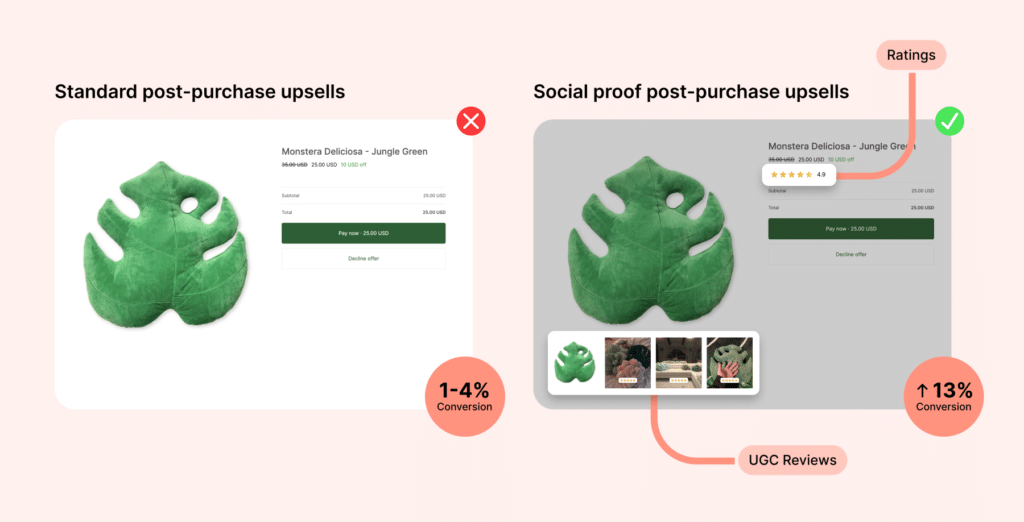
Is one of your add-on features more popular than another? Do you know how many choose either? Share that information when presenting it as an upsell or cross-sell. Something as simple as ‘7 out of 10 of our users say it significantly enhances their experience’ can appeal to and influence their decision-making process.
7. Keep an eye on your competitors
While it’s not really a CSM responsibility, there’s no shame in looking over to the other side of the fence to see what your competitors are doing. Analyzing your competition’s upselling and cross-selling strategies can reveal what the market is interested in and help you find gaps and untapped opportunities.
Don’t limit yourself to poking your nose around their website and cart pages. Buy their product or service – that’s the best way to get the full picture of what products they’re pushing both during your initial purchase and after.
Make notes about the products they sell and the price they sell them at. Look for similarities and differences between their offers and yours.
Adina Jipa, Founder & CMO @ SocialInsider, stated:
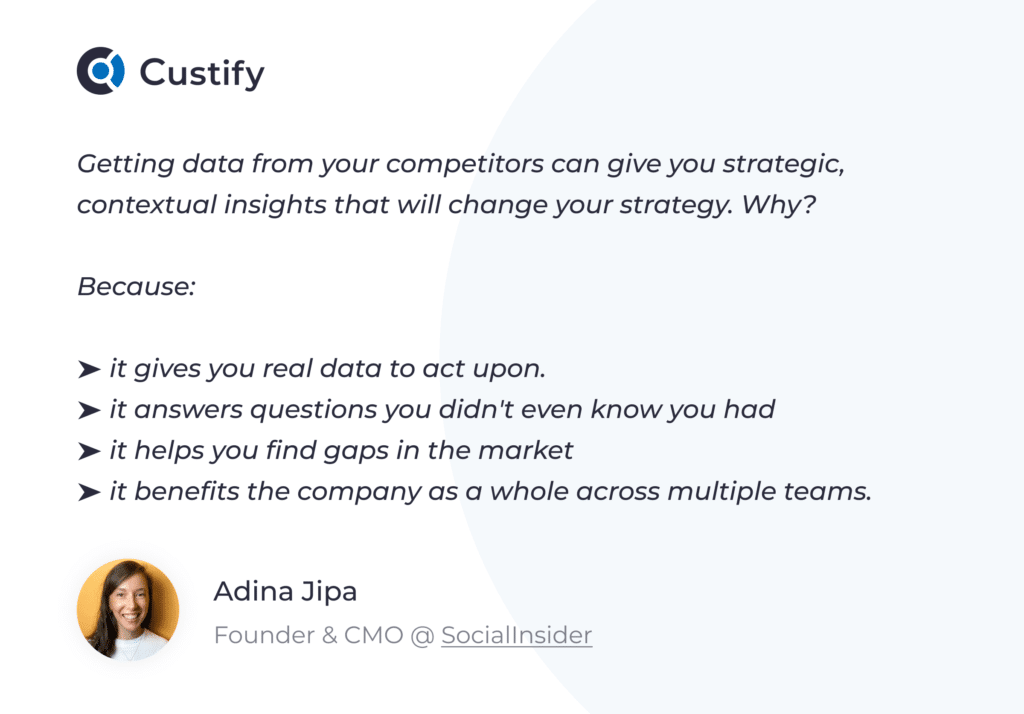
Common pitfalls of upselling and cross-selling
Alright. You’ve done your homework. You know everything about your customer’s needs, and you’ve segmented your buyers. All that’s left now is to put all the pieces together and roll out your new upsells and cross-sells, so you can start cashing in on your efforts.
Careful – you don’t want to shoot yourself in the leg by falling into any cross-selling and upselling pitfalls.
Now, it’s worth noting that lack of relevance is always one of these pitfalls – however, if you’ve done your homework, there’s no way you’re going to be making this mistake, so we’ll leave it out altogether.
A. Poor timing
A cross-sell (or upsell) is never late. Nor is it early. It arrives precisely when it needs to.
Alright, we might have stolen some of Gandalf’s words, but nothing kills the buzz of a SaaS company’s upselling and cross-selling strategy like poor timing. Present your upsell or cross-sell too early, and you’ll come off pushy and annoying. Leave it late, and you’ll have completely missed the sale. Presenting your users with upsells and cross-sells at every chance is also a big No-No.
So, when’s the right moment to make another ask from your customers? The short answer is: it depends. You need to factor in things such as the stage of the sales cycle, the level of rapport, or the overall level of satisfaction.
However, we can all agree that you can’t go wrong with offering an upsell after the customer has decided to buy. Just make sure you do so before he gets to the checkout page.
In the example below, Toggl, a time-tracking and management software, lets its users enjoy its benefits for one month before asking them to move to the paid version. Imagine sending the same email a couple of days after the trial started. It wouldn’t be anywhere nearly as impactful, would it?

If you want to get the timing right for other upsells or cross-sells, a proper CS software like Custify will tell you exactly when to reach out to your customers with your custom offer that may be too good to resist.
B. Failing to establish a connection with your customers
If you want your upsell and cross-sell strategy to succeed, do not think of your customers in terms of numbers. David Ogilvy once said: “The customer is not a moron. She’s your wife”.
So, taking this metaphor a step further, getting your customers to like you is much like courtship. You need to take your time to build rapport, build a personal connection. Don’t rush things. And always have their best interest in mind.
This doesn’t mean that you shouldn’t be pushing your offers through to them. If you’ve done your research right, your products will help solve their problems.
But don’t lead with the sale. Show them you understand their problems. Make them feel like you’re one of their own. Help them visualize how much better your upselling or cross-selling product will make their lives.
And if they say ‘No,’ don’t be too pushy with them. One or two follow-up emails may be fine. Five of them, however…
Check out this excellent communication example from Groove. Not only is it sent from their CEO, but the tone and the message construction make you feel like you’re talking to a friend and not someone who’s only after your money. This is what it’s all about.

C. Not communicating the value of your upsells and cross-sells
Let’s get one thing straight. When it comes to decision-making – and buying something is a decision – emotions are king. Fail to appeal to your customer’s emotions, motivations, and pain points, and your message will fall on deaf ears.
So, how do you do this? The most important thing to understand is that nobody cares about you or your product’s features. Instead, focus on the benefits of those features and use them to tap into their desires, aspirations, and concerns.
The real value of your products doesn’t lie in their list of features. It’s how those features will transform their life, solve their problems, or fulfill their deepest aspirations – that’s what matters most.
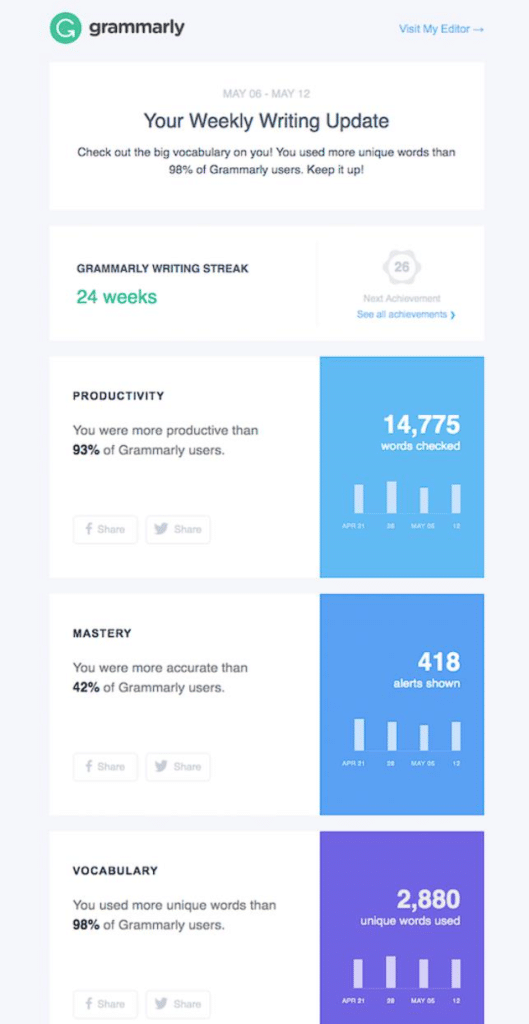
Take Grammarly’s example. Not only does this email play on their user’s emotions (You’ve used more unique words than 98% of Grammarly users.), but it does a fantastic job at conveying how much value users are getting from using the app (14,774 words checked; 418 alerts shown; 2,880 unique words used).
D. Avoid confusing or overwhelming your customers
A seamless buying experience is key to a solid SaaS upselling and cross-selling strategy. However, some companies might get too excited with their portfolio and present the customer with too many options.
This is something that can easily backfire. Paralysis by analysis is real, and when you show your customers an overwhelming array of choices, you’re only confusing them.

In the example above, TechSmith uses color-coded columns to highlight the different features available in its software offerings. However, presenting all 6 simultaneously may not be the best way to do it.
Instead of overwhelming your customers with numerous upselling and cross-selling options, prioritize a few that are relevant and valuable based on their needs and preferences.
In doing so, you’re guiding your customers toward a more confident and informed buying decision. This enhances their experience and maximizes your upsell and cross-sell strategy effectiveness.
E. Not measuring performance
As is the case for all your business efforts, if you’re not tracking and measuring the success of your strategy, not only are you not learning anything, but you’re also missing out on optimization opportunities. If you feel it’s important to compensate your CS team for upselling and cross-selling, you can use incentive compensation management software to track and pay commissions. It also helps you get insights into your team’s performance.

What’s more, tracking your efforts will allow you to paint an even more precise image of your customer’s behavior, preferences, and buying patterns.
Below are some key indicators for measuring your upselling and cross-selling strategy’s success:
- Average order value (AOV) – a healthy strategy should translate into more money from every order. As such, an AOV increase means you’re heading in the right direction.
- Customer lifetime value (CLV) – measured by multiplying your AOV by the average number of purchases/customer and the average retention rate. Once again, an increase in this KPI suggests you’re retaining more customers while also driving their satisfaction and loyalty up.
- Product Penetration Rate – reflects the number of customers purchasing multiple products. A higher rate can indicate the effectiveness of cross-selling.
- Expansion Conversion Rate – the percentage of customers who accept upsell or cross-sell offers. An increasing conversion rate might suggest better tactics, messaging or segmentation.
- Rate of Expansion Adoption – measure how quickly and extensively your customers are adopting the add-on products or services offered through upselling or cross-selling.
Best upselling and cross-selling examples in SaaS
Good! You now know all you need to know about creating a killer upselling and cross-selling strategy for your SaaS. However, a little dose of inspiration from some of the best to get those creative juices flowing wouldn’t hurt now, would it?
CyberGhost VPN
Remember how we talked about how the products or services your push alongside your initial one should enhance the customer’s experience? In this example, CyberGhost introduces 2 additional products on its pricing page.
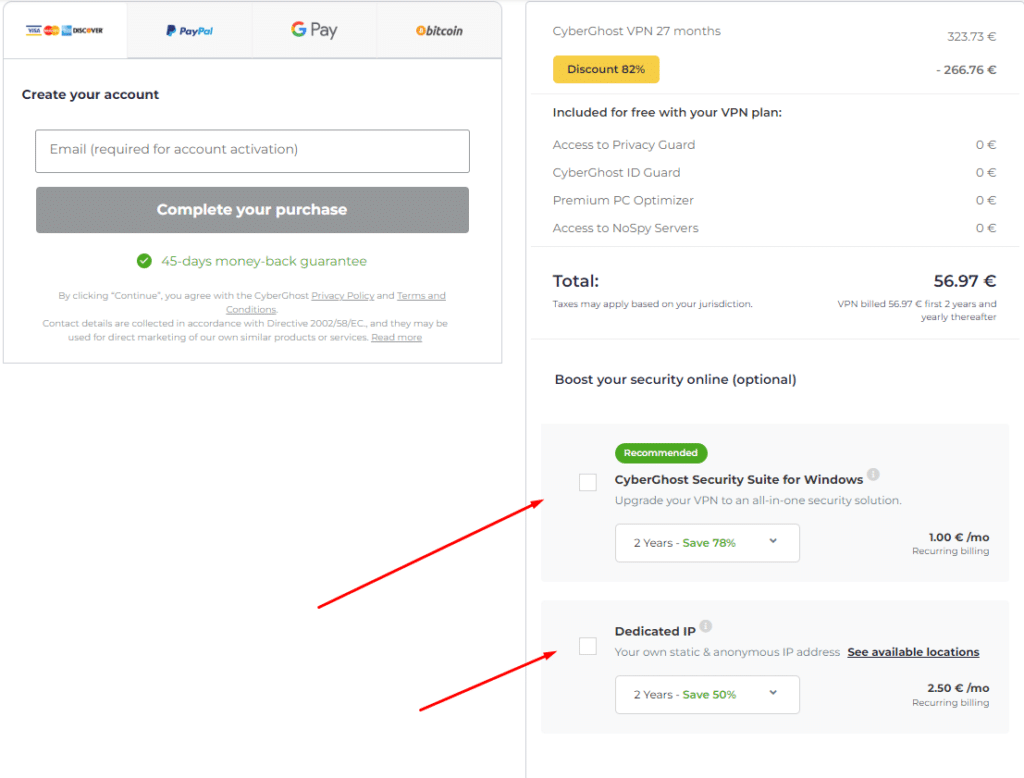
Notice the headline Boost your online security is crafted around the end benefit of the user. Be careful, though, with what you write. There’s a thin line between creating a yearning for more and lessening the appeal of your main product.
Asana
In general, it’s easier to get your existing paying customers to upgrade to a more expensive plan than it is to convince freemium users to switch to your paid version. And in-app messages are another excellent way to move them up to different pricing tiers – IF users are actually using it (so, make sure to do your homework).
In the example below, Asana doesn’t offer new users access to its Portfolio and Workload features.
And there’s a reason behind it – the value of these features is currently unknown to anyone who hasn’t used this service. However, as you become increasingly reliant on it, you’ll start seeing how these two features can make your life a lot easier when managing projects.

Evernote
While the example above highlighted the power of in-app messaging, it’s time to take a look at how to take advantage of other touchpoints you have with your users beyond your product.
Evernote harnesses the power of emails to convince users to upgrade to a Premium plan.

Conclusion
At the end of the day, upselling and cross-selling aren’t rocket science at all. If you’ve put in the hours to study your customers and figured out what they’re missing in their experience, creating an awesome strategy is only a matter of connecting the dots.
Only by leveraging your customer’s needs, preferences, and pain points can you identify the opportunities to offer additional products with irresistible value for your audience.
As you craft your strategy, do so with the mindset of providing genuine value rather than pushing unnecessary products or services. Focus on building trust and long-term relationships.
And don’t shy away from using a customer success platform as a trusted upselling and cross-selling ally. It’s like showing up for an exam and finding more than half of the answers are already filled in for you.

